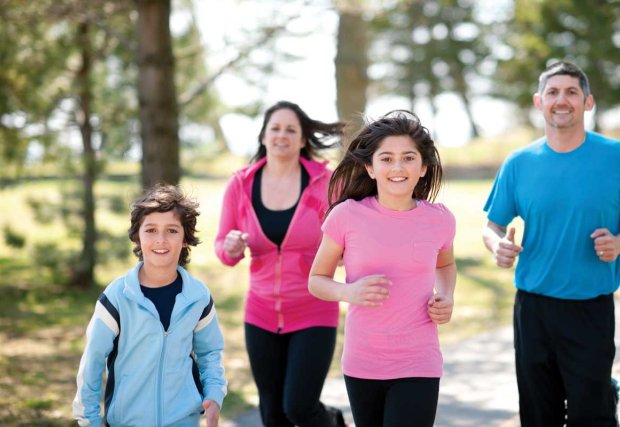Regular exercise is a must for kids! Follow these tips to make fitness a family affair.
There are so many reasons to make sure our kids are getting enough physical activity — from the mood-elevating power of playtime to the social skills learned in team sports. But, by far, the most important reasons to encourage exercise are the health benefits that come from an active lifestyle.
According to the Centers for Disease Control and Prevention, regular physical activity can help children and adolescents improve their cardiorespiratory fitness, build strong bones and muscles, control their weight, and even reduce symptoms of anxiety and depression. What’s more, kids who exercise have a reduced risk of developing a wide range of health conditions, including everything from heart disease and type 2 diabetes to high blood pressure, obesity and more.
Being active as a family makes having a healthy lifestyle less about discipline and more about enjoying good times together. Plus, it’s a powerful way to model habits that can last a lifetime. Whether your kids are in high school or still in diapers, below are some lively ways to focus on fitness as a family.
Plan a Park Day
Round everyone up (pets, too) and head to a park! You can play soccer, ride bikes on a trail, take the dog for a walk or monkey around on the jungle gym. Choose whatever type of park and activity best suits your family’s interests and abilities. Being outside is beneficial for your well-being and can be a nice change of pace from your daily routine. Pack water, sunscreen and snacks if you will be outside for a while.
Use an Activity as a Reward
If your kids bring home good report cards, do all of their chores or are brave during their booster shot, treat them to a fun activity like an afternoon at the local pool, a rollerblading outing or a trip to the playground. Rather than using a material reward like food or money, reinforce activity as a treat to teach your kids—and yourself—that fitness is fun.
Learn Something New
One of the best ways to bond while also being active is to learn something new together. Have you tried kayaking? What about stand-up paddleboarding? Rock climbing? Yoga? Find lessons and go as a family to learn how to do a new activity, which is as stimulating for you physically as it is mentally!
Move It Rain or Shine
You can still be active even if you’re stuck in the house because of rain or a heat wave. Follow an exercise video on TV or the internet that you can do with little ones, or find a hula hoop or jump rope and some space to play indoors. You can play charades, balloon volleyball or put on upbeat music and dance around to break a sweat. Whatever you do, know that even when you can’t get out of the house, you can still move it to stay fit together!
There are so many things competing for kids’ time and attention—from the lure of video games to the ease of binge-watching favorite shows to the demands of school work—making it easy for youngsters to settle into a sedentary lifestyle. But the benefits of regular physical activity are simply too powerful to ignore. Help put your kids on a path to better health by focusing as a family on physical fitness.
Just How Much Exercise Do Kids Need in Order to Reap Rewards?
The Centers for Disease Control and Prevention recommend that children and adolescents age 6 through 17 should do at least 60 minutes of moderate-to-vigorous physical activity every day. According to the Physical Activities Guidelines for Americans, 2nd edition, issued by the U.S. Department of Health and Human Services, these activities should include the following:
Aerobic
Most of the 60 minutes or more per day should be either moderate- or vigorous-intensity aerobic physical activity and should include vigorous-intensity physical activity on at least three days a week.
These are activities in which young people rhythmically move their large muscles. Examples include things like running, skipping, jumping rope, dancing and bicycling.
Muscle-strengthening
As part of their 60 minutes or more of daily physical activity, children and adolescents should include muscle-strengthening physical activity on at least three days a week.
These are activities that make muscles do more work than usual. Examples include things like playing on playground equipment, climbing trees and playing tug-of-war.
Bone-strengthening
As part of their 60 minutes or more of daily physical activity, children and adolescents should include bone-strengthening physical activity on at least three days a week.
These types of activities produce a force on the bones that promotes bone growth and strength. Examples include things like basketball, tennis and hopscotch.

